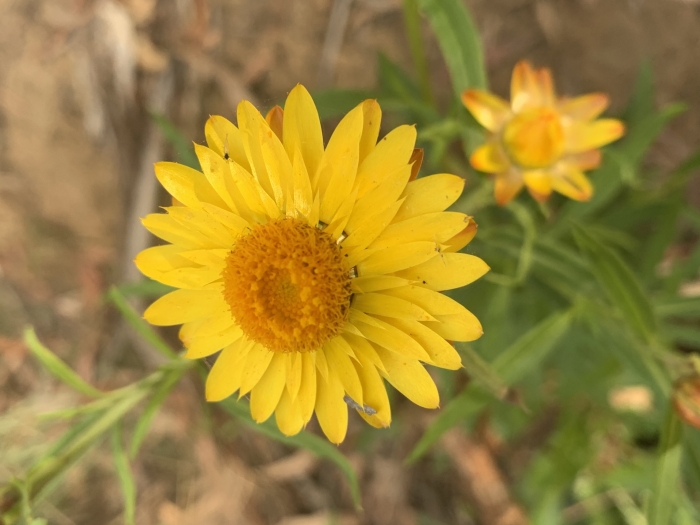Golden Everlasting
(Xerochrysum bracteatum)
Golden Everlasting (Xerochrysum bracteatum)
/
/

Guy Taseski
CC BY 4.0
Image By:
Guy Taseski
Recorded By:
Copyright:
CC BY 4.0
Copyright Notice:
Photo by: Guy Taseski | License Type: CC BY 4.0 | License URL: http://creativecommons.org/licenses/by/4.0/ | Rights Holder: Guy Taseski | Publisher: iNaturalist | Date Created: 2021-05-30T05:07:57Z |



















































Estimated Native Range
Summary
Xerochrysum bracteatum, commonly known as Golden Everlasting, is a perennial herb that can be deciduous or semi-deciduous depending on the climate. It is native to a variety of habitats including open forests, grasslands, and alpine regions of Australia. Typically, it reaches a height of 1-3 feet (30-90 cm) with a similar spread. Golden Everlasting is renowned for its papery, daisy-like flowers that bloom in shades of yellow, gold, and white. The flowering season extends from spring to autumn, with peak bloom in summer. The flowers are particularly showy and are known for their longevity, both on the plant and when used in dried floral arrangements.
This plant is valued for its drought tolerance and long-lasting flowers, making it an excellent choice for hanging baskets, border plantings, and as a cut flower. It is also a butterfly attractor, enhancing the biodiversity of garden spaces. Golden Everlasting requires acidic, well-aerated soils with a pH of 5.5 to 6.3 and low levels of phosphorus. It is sensitive to iron deficiency, which can cause chlorosis. While it was developed in Germany in the 1850s, it has since become popular worldwide, with many cultivars offering a range of flower colors. It thrives in full sun and can tolerate low to medium water conditions, preferring soils with medium to fast drainage.CC BY-SA 4.0
This plant is valued for its drought tolerance and long-lasting flowers, making it an excellent choice for hanging baskets, border plantings, and as a cut flower. It is also a butterfly attractor, enhancing the biodiversity of garden spaces. Golden Everlasting requires acidic, well-aerated soils with a pH of 5.5 to 6.3 and low levels of phosphorus. It is sensitive to iron deficiency, which can cause chlorosis. While it was developed in Germany in the 1850s, it has since become popular worldwide, with many cultivars offering a range of flower colors. It thrives in full sun and can tolerate low to medium water conditions, preferring soils with medium to fast drainage.CC BY-SA 4.0
Plant Description
- Plant Type: Herb
- Height: 1-5 feet
- Width: 0.5-1.5 feet
- Growth Rate: Moderate
- Flower Color: Yellow, Orange, Pink, Red, White
- Flowering Season: Summer, Fall
- Leaf Retention: Deciduous, Semi-deciduous
Growth Requirements
- Sun: Full Sun
- Water: Low, Medium
- Drainage: Medium, Fast
Common Uses
Bee Garden, Border Plant, Butterfly Garden, Deer Resistant, Groundcover, Low Maintenance, Potted Plant, Rock Garden, Salt Tolerant, Showy Flowers, Street Planting
Natural Habitat
Native to open forests, grasslands, and alpine regions of Australia
Other Names
Common Names: Everlasting Flower, Paper Daisy, Paper-Flower, Yellow Paper Daisy, Golden Everlasting, Straw Daisy, Strawflower, Garten-Strohblume, Flor De Palha, Sempre-Viva
Scientific Names: , Helichrysum bracteatum, Elichrysum bracteatum, Xerochrysum bracteatum, Gnaphalium bicolor, Bracteantha bracteata, Helichrysum monstrosum, Helichrysum macranthum, Xerochrysum macranthum, Helichrysum lucidum
GBIF Accepted Name: Xerochrysum bracteatum (Vent.) Tzvelev